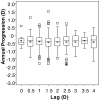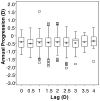Accommodative lag and juvenile-onset myopia progression in children wearing refractive correction
- PMID: 21342658
- PMCID: PMC3111954
- DOI: 10.1016/j.visres.2011.02.016
Accommodative lag and juvenile-onset myopia progression in children wearing refractive correction
Abstract
The relationship between accommodative lag and annual myopia progression was investigated using linear models in 592 myopic children wearing a full refractive correction in the Collaborative Longitudinal Evaluation of Ethnicity and Refractive Error (CLEERE) Study. The mean (± SD) age and spherical equivalent refractive error at baseline were 10.4 ± 1.8 years and -2.13 ± 1.24 D, respectively. The mean annual progression of myopia was -0.45 ± 0.32 D, and the mean accommodative lag (for a 4-D Badal stimulus) was 1.59 ± 0.63 D. Neither lag at the beginning nor at the end of a yearly progression interval was associated with annual myopia progression (all p ≥ 0.12). These data suggest that foveal hyperopic retinal blur during near viewing may not drive juvenile-onset myopia progression.
Copyright © 2011 Elsevier Ltd. All rights reserved.
Figures






References
-
- Abbott ML, Schmid KL, Strang NC. Differences in the accommodation stimulus response curves of adult myopes and emmetropes. Ophthalmic Physiol Opt. 1998;18(1):13–20. - PubMed
-
- Adler D, Millodot M. The possible effect of undercorrection on myopic progression in children. Clin Exp Optom. 2006;89(5):315–321. - PubMed
-
- Allen PM, O’Leary DJ. Accommodation functions: co-dependency and relationship to refractive error. Vision Res. 2006;46(4):491–505. - PubMed
-
- Atchison DA, Pritchard N, Schmid KL. Peripheral refraction along the horizontal and vertical visual fields in myopia. Vision Res. 2006;46(8–9):1450–1458. - PubMed
Publication types
MeSH terms
Grants and funding
LinkOut - more resources
Full Text Sources
Other Literature Sources
Medical

